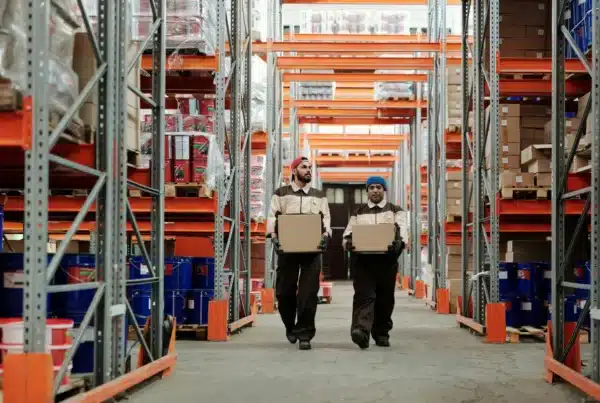
An ideal supply chain is a seamless flow of goods that runs smoothly between your various locations and to your customers.
Disruption is minimized, punctuality is maximized, and cost-effectiveness is optimized. Sounds great, right?
You may think you already have this, but without a comprehensive overview of your supply chain operations, how can you be sure? There could be enormous inefficiencies hamstringing your productivity and curtailing your revenue.
Without full supply chain visibility, both these issues and opportunities for improvement could go completely overlooked.
And this issue is more common than you might think. Only 6% of companies report having full visibility over their entire supply chain, and 69% believe their level of visibility is so low as to be a risk to their reputations.
The level of risk created by this uncertainty is a huge problem for businesses, especially in the current economic climate. In this article we’ll explore what makes supply chain visibility important, and how you can improve supply chain visibility to maximize productivity and profitability with a few instrumental additions.
What do we mean by “supply chain visibility”?
Supply chain visibility (or SCV) can describe both:
For the purposes of this article, we will be talking about both types.

Why supply chain visibility matters
A highly visible supply chain provides a large amount of data relating to your operations and efficiencies, such as:
- Real-time shipment location
- Freight cost and comparative freight costs
- Carrier rates
- Transportation routes
- Shipment delays
- Inventory levels
When analyzed, this data makes it possible to identify multiple opportunities for alterations and optimizations of the logistics process. These changes can greatly benefit the efficiency, effectiveness and resilience of your business in several ways:

How to improve supply chain visibility
The entire reason behind wanting to gain full visibility over your supply chain is to help you make the most informed decisions possible on each element of your logistics. In order to do this, you need to be sourcing insights and analytics from across the entirety of your supply chain.
Tracking technology
Technology such as IoT (Internet of Things) devices, RFID tags and satellite tracking can help you monitor the movement of your freight in real time. This can help you track individual shipments, providing greater clarity in the event of disruptions so you can adjust warehouse staffing accordingly. Over time, multiple recorded journeys will build up a picture that can help you spot bottlenecks or repeated friction points on your shipping routes.
Shipment optimization software
Trying to run your shipping operations without dedicated software today is akin to pouring money down the drain. The amount of valuable data that can be gleaned from logistics operations is far beyond what even the most talented administrators can manage with spreadsheets.
Shipment optimization software takes all the real-time freight tracking and supply chain efficiency data and presents it to you in a simple, user-friendly way.
The improvements that can be made to efficiency with this software are enormous. For perspective, one of our clients, a multi-billion-dollar retailer, had previously managed all of their logistics operations through spreadsheets. This meant their fleet managers were having to call carriers directly to assign loads and check up on the location of shipments.
This business now uses our Allink360™ software, and the improvements from this digital transformation have been dramatic. In the first year alone, they saved over 30% on their logistics overheads by optimizing carrier selection and adjusting warehouse staffing according to shipment departure and arrival times. This was all made possible by the increased visibility afforded by the shipment optimization software.
Centralize data and improve collaboration with partners
If all the information you collect on your supply chain comes solely from your company’s perspective, you’re only getting half the story. To truly enhance supply chain visibility, it’s vital that you establish robust collaborations with your partners and centralize all data collected.
The integration of your software system with partners’ IT infrastructure is a strategic move. By sharing data seamlessly, you not only improve visibility for your own network but also contribute to the efficiency of your partners’ operations. If your partners receive advanced shipping notices, status updates and proactive alerts directly, they can streamline their operations without needing to contact you, making the entire process more efficient.

Final thoughts
In the modern logistics landscape, increased supply chain visibility is not just a luxury but a necessity. The impact enhanced visibility has for almost every aspect of supply chain management is enormous, and can be completely transformative.
In a world where every detail matters, a well-optimized and transparent supply chain becomes a competitive advantage, ensuring resilience and success in the face of evolving challenges. From efficient staffing allocation to route optimization, carrier selection and real-time risk management, the benefits of supply chain visibility improvements cannot be overstated.
Realizing these advantages requires embracing cutting-edge solutions like shipment optimization software and fostering collaborative relationships with partners.
At Harte Hanks, our Allink360™ software has simplified and optimized supply chain management for national and multinational clients alike, and resulted in significant cost savings and operational efficiencies. With over 9,000 vetted carriers across North America at your fingertips, real-time freight tracking and granular spend data, Allink360™ enables you to squeeze every last ounce of efficiency from your supply chain.
Contact us today.

Mark is the Vice President of Business Development at Harte Hanks. He is seasoned Senior Supply Chain Sales and Operations Executive with over 30 years’ experience. Mark specializes in fostering strategic initiatives that utilize technology and data analysis to maximize cost savings and customer loyalty for major brands.



